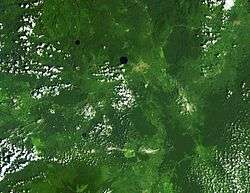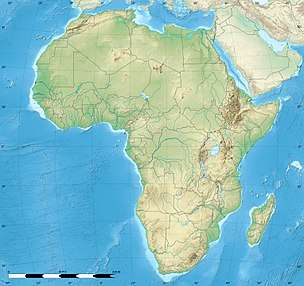Lake Barombi Koto
Lake Barombi Koto, also known as Lake Barombi Kotto or Lake Barombi-ba-Kotto, is a small lake in the volcanic chain in the Southwest Region of Cameroon. It is a volcanic lake with a diameter of about 1.2 km (0.75 mi).[1] There is a small island in the middle, which is densely inhabited by the Barombi, a tribe of fishers.[1] The Tung Nsuia and Tung Nsuria streams, each about 1–2 m (3 ft 3 in–6 ft 7 in) wide and 0.3 m (1 ft 0 in) deep near their mouth, are the only inflows into the lake,[1] and they dry out in dry season.[2]
| Lake Barombi Koto | |
|---|---|
 Of the three visible lakes, Barombi Koto is the relatively small circular lake in the southwest. | |
 Lake Barombi Koto  Lake Barombi Koto | |
| Coordinates | 4°28′N 9°16′E |
| Type | Volcanic crater lake |
| Primary inflows | Tung Nsuia and Tung Nsuria streams[1] (dry out in dry season)[2] |
| Primary outflows | Nkundung-Kotto Stream (dries out or greatly reduced in dry season), which is a tributary of the Meme River[2] |
| Basin countries | Cameroon |
| Max. length | 2.2 km (1.4 mi)[2] |
| Max. width | 2 km (1.2 mi)[2] |
| Surface area | 330 hectares (820 acres)[2] |
| Average depth | 3.8 m (12 ft)[2] |
| Max. depth | 6.2 m (20 ft)[2] |
| Water volume | 1,248,000 m3 (44,100,000 cu ft)[2] |
| Surface elevation | 110 m (360 ft)[2] |
| Islands | Kotto (name of village on small island)[2] |
Biology
Lake Barombi Koto often appears green-brown because it is rich in phytoplankton.[1] Invertebrates, turtles and the aquatic frog Xenopus tropicalis are common in the lake,[1][2] which is also an important sanctuary for birds.[3] Seven fish species are known from the lake, including Enteromius callipterus and a Clarias catfish, while the remaining all are cichlids: Coptodon kottae, Chromidotilapia guentheri, Hemichromis fasciatus, Pelmatolapia mariae and Sarotherodon galilaeus.[1] Of these, C. guentheri is represented by the endemic subspecies loennbergi, while C. kottae is entirely endemic to this lake and the smaller Lake Mboandong. A review in 2008 was unable to confirm the distinction of the subspecies loennbergi compared to C. guentheri elsewhere, but the H. fasciatus in Barombi Koto and Lake Mboandong are unusually small and might be an endemic undescribed species.[4] The endemics are threatened by pollution and sedimentation from human activities, and "turning" of the lake's water because of deforestation of the surroundings (this may allow more wind, and the lake is stratified with oxygen-poor lower levels).[5][6] They are potentially also threatened by large emissions of carbon dioxide from the lake's bottom (compare Lake Nyos),[5][6] although Barombi Koto is too shallow to contain very high amounts of this gas.[7]
The nothobranchiids Aphyosemion bivittatum, Epiplatys sexfasciatus and Fundulopanchax oeseri, the poeciliid Procatopus similis, and Barbus callipterus are found in the Tung Nsuia and Tung Nsuria streams.[1]
Bulinus snails (including the near-endemic B. camerunensis) infested with Schistosoma, which causes the disease bilharzia in humans, are present in the lake.[8]
Lake Mboandong
About 1 km (0.6 mi) south of Lake Barombi Koto is the even smaller Lake Mboandong, another shallow crater lake with a diameter of about 0.4 km (0.25 mi).[1] There is no inflow and the only outflow is a small stream during the wet season.[1]
Lake Mboandong is less rich in phytoplankton and has less fish species, but all are species shared with Lake Barombi Koto and its inflowing streams: Aphyosemion bivittatum, Fundulopanchax oeseri, Coptodon kottae, Hemichromis fasciatus and Sarotherodon galilaeus.[1] Members of the Barombi tribe that live at Lake Barombi Koto sometimes visit Lake Mboandong to fish.[1]
References
- Corbet, S. A., J. Green, J. Griffith, and E. Betney (1973). Ecological studies on crater lakes in West Cameroon Lakes Kotto and Mboandong. Journal of Zoology 170: 309–324
- Trewavas, E. (1962). Fishes of the Crater Lakes of the Northwestern Cameroons. Bonner Zoologische Beitraege 13: 146–190
- Hughes, R.H., and J.S. Hughes (1992). A Directory of African Wetlands. Pp. 474–475. ISBN 2-88032-949-3
- Stiassny, M.L.J.; A. Lamboj; D. De Weirdt; G.G. Teugels (2008). "Cichlidae". In M.L.J. Stiassny; G.G Teugels; C.D. Hopkins (eds.). The fresh and brackish water fishes of Lower Guinea, West-Central Africa / Poissons d'Eaux Douces et Saumâtres de Basee Guinée, Ouest de l'Afrique Centrale. 2. Muséum national d'Histoire naturelle, Musée Royal de l'Afrique Centrale. pp. 269–403.
- Moelants, T. (2010). "Chromidotilapia guntheri ssp. loennbergii". IUCN Red List of Threatened Species. 2010. Retrieved 5 February 2012.CS1 maint: ref=harv (link)
- Moelants, T. (2010). "Tilapia kottae". IUCN Red List of Threatened Species. 2010. Retrieved 5 February 2012.CS1 maint: ref=harv (link)
- Freeth, S.J.; C.O. Ofoegbu; and K.M. Onuoha (1992). Natural Hazards in West and Central Africa, pp. 50–51. ISBN 978-3-663-05239-5
- Atemnkeng, A. F., K. J. N. Ndamukong, N. N. Ntonifor, and J. Mbuh (2006). Life cycle, population dynamics and schistosome infection in Bulinus spp. from a crater lake in the South West Province of Cameroon. Journal of the Cameroon Academy of Science 6(2): 99–105